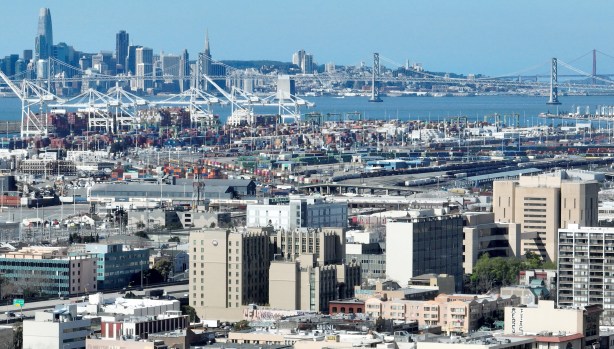A drone view of downtown Oakland, the Port of Oakland and the San Francisco skyline, March 2024.
The Bay Area and California both lost thousands of jobs in February, disquieting news that raises questions about the strength of the economy regionally and across the state.
The nine-county region lost 4,200 jobs in February, while California, bolstered by hefty job gains in Orange County and Sacramento County, as a whole shed 3,400 jobs last month, a setback that ended six straight months of statewide employment gains, according to a state Employment Development report released Friday.
The figures suggest the hiring boom that began in the final few months of 2023 and extended into January of this year has been interrupted, at least for now.
 “The Bay Area and state economy are struggling to add jobs and reduce unemployment,” said Steve Levy, director of the Palo Alto-based Center for Continuing Study of the California Economy. “These trends add to concerns about state and local budgets.”
“The Bay Area and state economy are struggling to add jobs and reduce unemployment,” said Steve Levy, director of the Palo Alto-based Center for Continuing Study of the California Economy. “These trends add to concerns about state and local budgets.”
The net job losses in the Bay Area were more severe than the statewide staffing reductions that jolted California.
“The Bay Area continues to be the epicenter of job loss in California,” said Scott Anderson, chief U.S. economist for BMO Capital Markets.
Job losses in the tech industry and construction, in particular, shoved job totals lower here, the state report showed. But those cuts have been softened somewhat by gains elsewhere.
“In the Bay Area, the shedding of jobs by high-profile tech firms has been offset in good part by hiring in smaller firms and start-ups,” said Michael Bernick an employment attorney with law firm Duane Morris and a former director of the state EDD.
Hotels, restaurants and health care companies in the Bay Area also added jobs at a brisk pace in February, according to a Beacon Economics assessment of the state employment reports.
Still, all three of the Bay Area’s largest metro centers lost jobs in February. The South Bay lost 100 jobs, the East Bay shed 2,400 jobs, and the San Francisco-San Mateo region lost 1,000 jobs.
“One month does not make a trend, but if declines continue, we’ll need to reassess,” said Justin Niakamal, research manager with Beacon Economics, which tracks state and regional economies in California and elsewhere.
The statewide jobless rate worsened to 5.3% in February, up from 5.2% in January, according to the state’s monthly report — far worse than California’s record-low unemployment rate of 3.8% in August 2022.
All of the numbers were adjusted for seasonal variations.
The new state employment report also revealed the job gains reported for January were far weaker than first thought. Rather than gaining 13,600 jobs that month as initially estimated, the Bay Area added only 1,900 positions.
Similarly, California originally was thought to have added a robust 58,100 jobs in January. It turns out the state gained 25,600 positions — less than half the initial estimate.
According to seasonally adjusted estimates Beacon Economics derived from the official state reports, tech companies chopped a net total of 3,200 jobs in February, while construction companies slashed 4,500 jobs. Hotels and restaurants gained 2,200 jobs, and health care employers added 1,800.
The tech industry losses were particularly severe in the South Bay, which lost 1,700 such jobs in February, according to the Beacon estimates.
Companies such as Facebook app owner Meta Platforms, Google, Cisco Systems, Salesforce and Intel have slashed jobs in a quest to operate more efficiently after hiring sprees during the pandemic.
“The tech sector is on an efficiency push right now, and it’s bringing big dividends in terms of stock market performance and market share,” said Russell Hancock, president of Joint Venture Silicon Valley, a San Jose-based think tank. “Job growth is likely to follow.”
The staffing reductions for construction workers are occurring at a time of turmoil for both the residential and commercial real estate industries. Sky-high interest rates and soaring office vacancies have coalesced to make it difficult to build new offices and apartments.
On a more hopeful note, the hotel and restaurant sectors continue to hire in a big way. Lodging and dining operators added 700 jobs in the South Bay, 600 in the East Bay and another 600 in the San Francisco-San Mateo region.
With the end of coronavirus-linked business shutdowns and travel restrictions, experts believe people want to travel more and dine more often in restaurants. Plus, conventions and business gatherings may be on the rise.
This week, Nvidia staged a conference in San Jose focused on the fast-rising artificial intelligence sector. The event attracted throngs of employees, AI industry leaders and entrepreneurs, which bolstered hotels and restaurants in the downtown district.
“Most places around the country would be happy to trade with us,” Hancock said.
But the employment losses in February dismayed economists and created a murky economic picture and unsettling outlook for the Bay Area.
“We had thought the jobs numbers would continue to move positively, but February seems to have ended any momentum we had,” said Jeff Bellisario, executive director of Bay Area Council Economic Institute.
The losses also leave the Bay Area even further away from its pre-coronavirus record-high employment levels. The nine-county region is 62,000 jobs short of its employment pinnacle in February 2020.
“The Bay Area employment roller coaster continues,” Bellisario said, “and it is likely to stay that way for much of 2024.”
This post was originally published on 3rd party site mentioned in the title of this site





